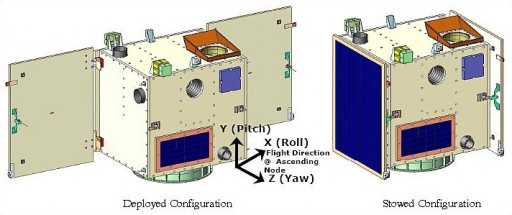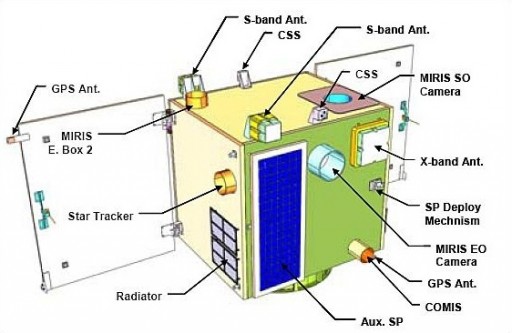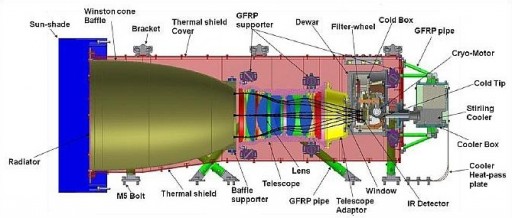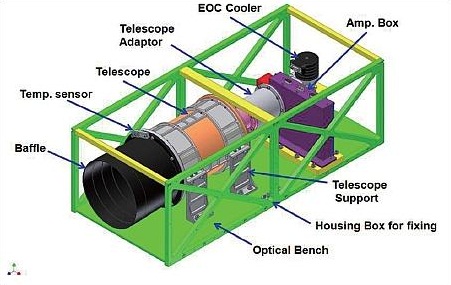STSat-3


The second of the two primary payloads is STSat-3 – the Science and Technology Satellite-3 which is a multi-purpose microsatellite that was designed and developed by the Satellite Technology Research Center of the Korea Advanced Institute of Science and Technology. The satellite weighs 150 Kilograms and is 1.024 by 1.030 by 0.885 meters in size. It carries two main payloads, the Multi-purpose Infrared Imaging System and the Compact Imaging Spectrometer.
The satellite is three-axis stabilized with a pointing accuracy of 0.13 degrees. Attitude data is provided by Coarse Sun Sensors, four gyros, two star trackers and a Tri-Axis Magnetometer. A GPS receiver provides on-orbit position and timing. Attitude control is provided by a Reaction Wheel Assembly consisting of four wheels. Satellite propulsion is provided by a 679-Watt Hall-thrust Propulsion Subsystem.
The HPS is an experimental payload weighing 14.6 Kilograms. Using Xenon, the system provides 10 Millinewtons of thrust.
The satellite is equipped with two solar arrays, a Solar Array Power Regulator, Power Supply Unit and a Power Distribution unit as well as a 20 Amp-hour Li-Ion battery for power storage. The arrays provide 286 Watts of power. The electronics manage battery state of charge and generate an unregulated power bus that is then converted to regulated 5, 12 and 20-Volt buses. The satellite uses an RS-422 analog data bus for telemetry and command handling and a high-speed LVDS bus that achieves data rates of 1.2Mbit/s for payload data handling. The Command & Data Handling Subsystem manages the spacecraft and payload functions according to uplinked ground commands. It also stores the payload data and provides them for downlink to the ground. The satellite is equipped with a Mass Memory of 32 Gbit.
The spacecraft uses an S-Band system with up to 9.6kbit/s for uplink and 38.4kbit/s for downlink. S-Band is used for command uplink and housekeeping telemetry downlink. Payload data is downlinked via a high-speed X-Band system.

The main payload of the STSat-3 spacecraft is the Multipurpose Infrared Imaging System – MIRIS. The instrument will survey the Galactic plane to detect the cosmic infrared background using two infrared cameras – MSOC (MIRIS Space Observation Camera) for near IR observations of the diffuse warm ionized medium in the Galaxy plane with a Field of View of 360º x 6°, and MEOC (MIRIS Earth Observation Camera) to conduct Earth observations.
MSOC covers a spectral range of 0.9 to 2 micrometers. The imager has an aperture diameter of 80 millimeters. The optics consist of five lenses – all of them are spherical with the exception of the rear of the fifth lens which is asymmetrical. A Winston Baffle is attached in front of the telescope to block strong radiation from Earth’s surface. MSOC is equipped with an actively cooled infrared detector of 256 by 256 pixels creating a detector field of view of 3.67 by 3.67 degrees.
The MEOC instrument features a Cassegrain telescope and relay lens systems. The telescope utilizes zerodur aspherical mirrors and germanium and silicon lenses attached behind the telescope. A warm stop is inserted behind the lens system to reduce thermal noise using a bandpass filter of 3.8 to 4.8 micrometers.

MEOC covers a spectral range of 3 to 5 micrometers using an effective aperture diameter of 100mm. It uses an HgCdTe detector that is cooled to 80K. The detector is 320 by 326 pixels in size creating a detector field of view of 1.1 by 1.1 degrees and a pixel field of view of 12.4 by 12.4 arcsec. MEOC achieves a ground pixel size of 42 meters and covers a 13.4-Kilometer ground swath. MEOC can take up to 5 images per second, but will usually be operated at 1fps. Its exposure time can vary from 1ms to 655ms.
The Compact Imaging Spectrometer – COMIS is an imaging spectrometer to acquire hyperspectral images over a 28km swath with a 30 or 60-meter spatial resolution that can be ground-commanded. The instrument covers a spectral range of 0.4 to 1.05 micrometers and achieves a spectral resolution of 2 to 15 nanometers.
COMIS uses a Maksutov catadioptric telescope and an imaging spectrometer. The telescope provides an image of the ground swath onto the spectrometer entrance slit. The spectrometer then re-images the collected light, disperses it in the direction perpendicular to the slit image, and focuses it on the detector. COMIS uses a CCD array detector system with pixel sizes of 13 by 13 micrometers.
